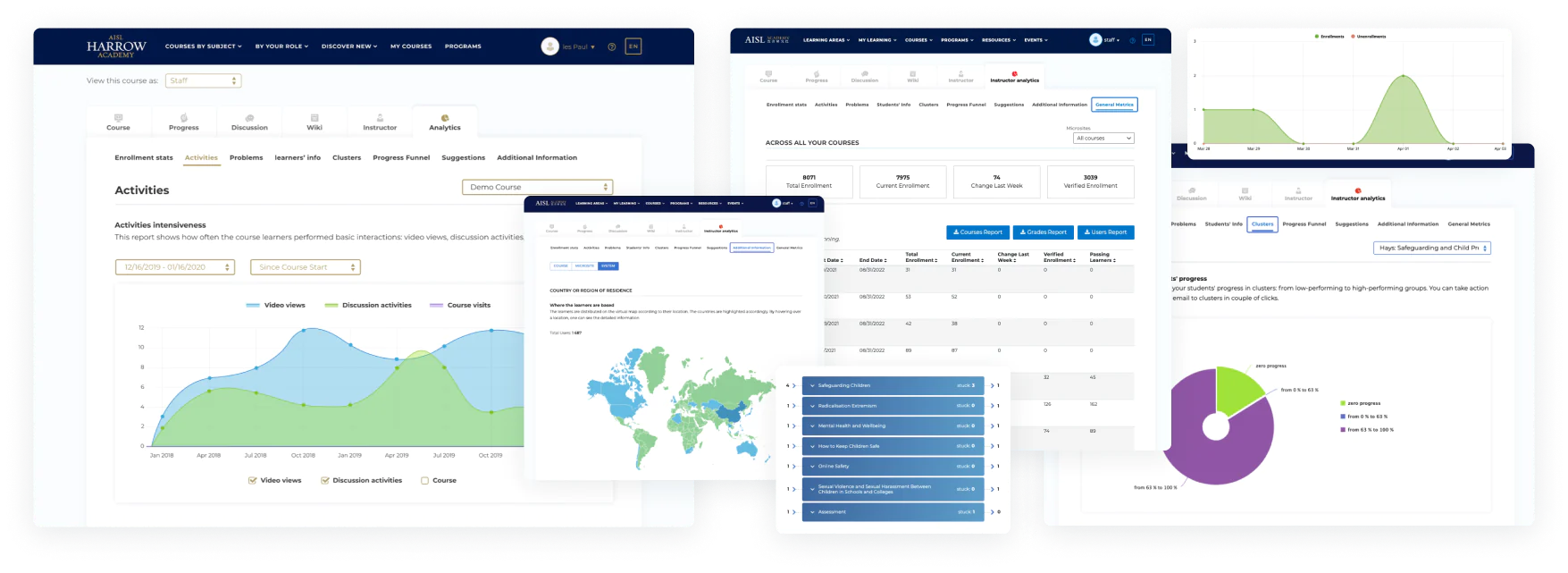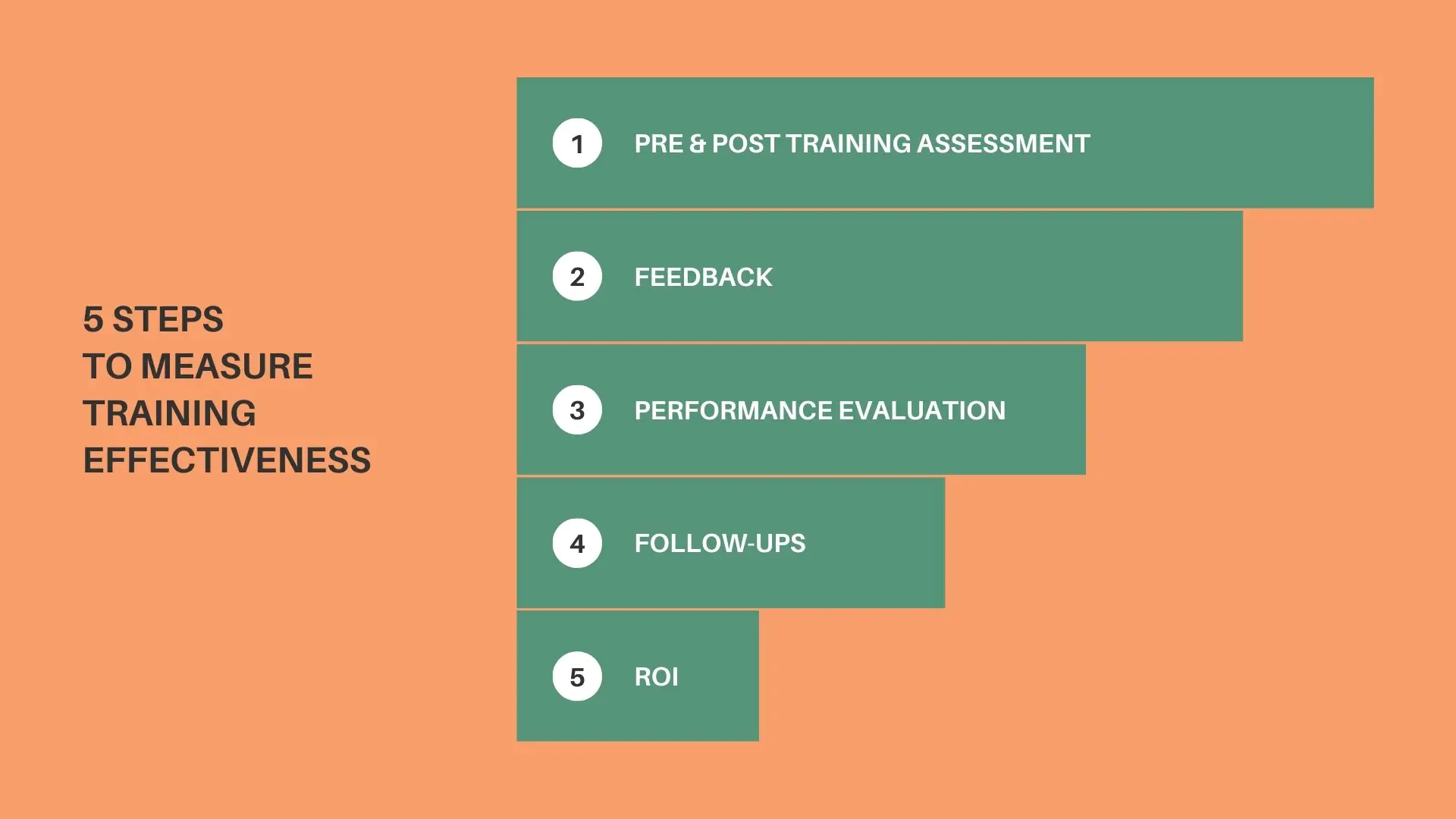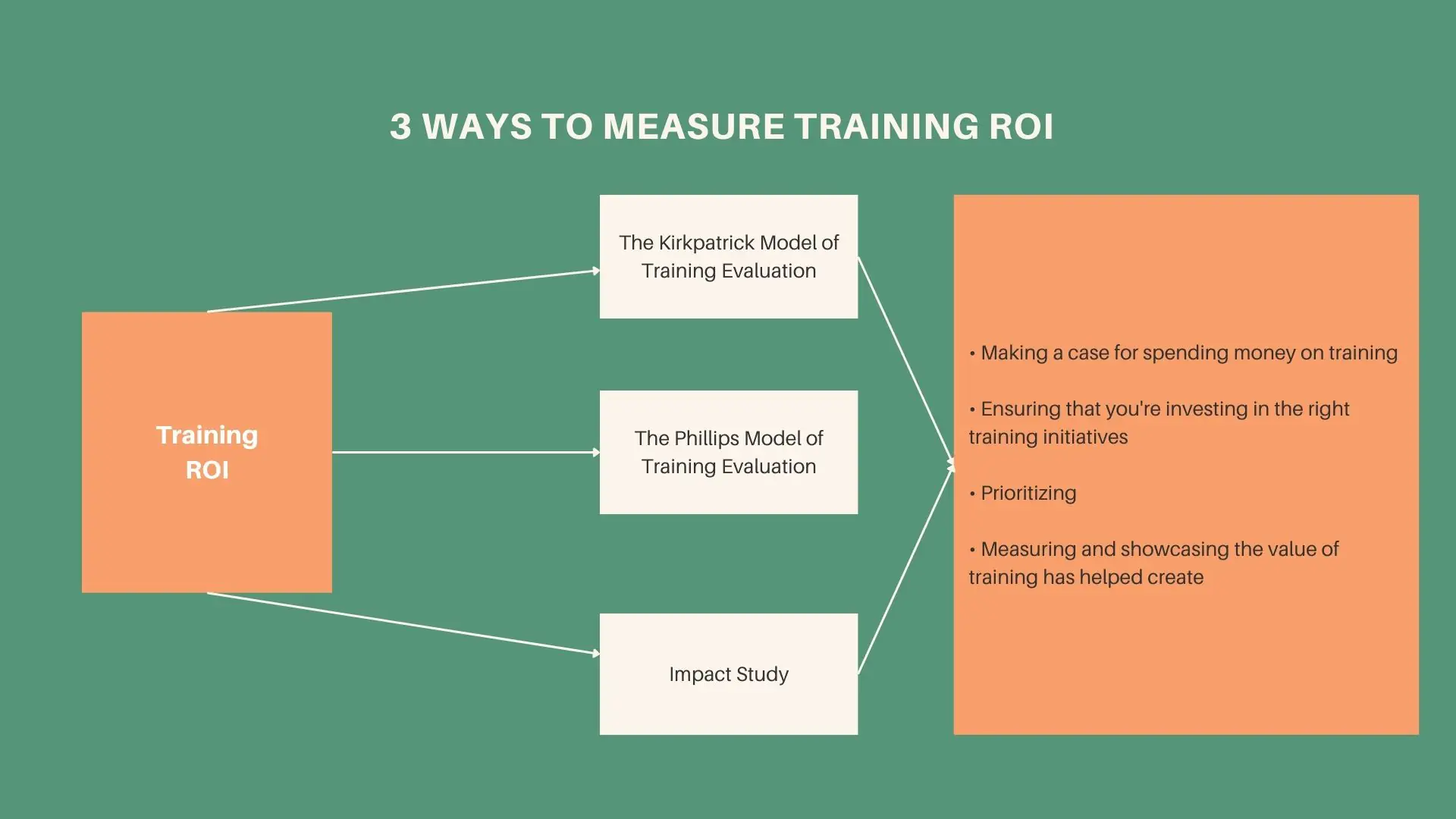Do you know if your training programs are truly making an impact, or are you just guessing? Without LMS analytics, it’s hard to see what’s working, where gaps exist, or how to prove ROI. Many organizations face these challenges, struggling to improve results. With LMS reporting and analytics, you can get the insights you need to make better decisions, refine training, and show its impact.
This article will help you solve these issues with practical steps for better outcomes.
Key highlights:
- How LMS analytics enhance training effectiveness through detailed data insights.
- A clear development roadmap to implement LMS analytics.
- Important tech nuances to consider when working with LMS analytics.
To see how these strategies work in real life, check out our case study on the Harrow e-learning platform for AISL Academy. For example, we added actionable, real-time reports to the LMS, helping instructors gather detailed course statistics and track student progress.
Maximizing Training Success Through LMS Analytics
LMS analytics gives you the tools to track and measure your training programs. You can see how well learners are doing, spot areas where they need help, and improve the effectiveness of your training.
Real changes in training don’t happen with fanfare; they unfold quietly over time. LMS analytics for corporate training programs reflect this. While sudden data spikes may catch attention, the real power lies in recognizing long-term trends that steadily reshape how training is delivered.
Like the tide, these trends build strength slowly but have a lasting impact. Moreover, by tracking LMS reports and analytics, organizations can identify subtle shifts in learner behavior and performance.
As our article on reporting and analytics explains, your LMS can show you key numbers like course completion rates, test scores, and how engaged learners are. With data analytics for LMS, you can make smarter decisions to improve training and get better results. Furthermore, using LMS learning analytics helps you understand what works in your training. Make adjustments on time to get even better outcomes.
Simple Types of Analytics Reports
| Type of Report | Key Features | Data Included | Tech Needed | Use Cases | Results |
| Performance Reports | Tracks learner progress | Completion rates, test scores, retention | Basic LMS tools | See how well learners are doing | Spot areas where learners need help |
| Custom Reports | Tailored to your needs | Custom data (e.g., by department or team) | Advanced reporting tools | Find trends in specific groups | Make targeted improvements |
| Engagement Reports | Measures how involved learners are | Time spent on content, participation in activities | Engagement tracking tools | Check how learners are interacting with the content | Keep learners more engaged |
| Compliance Reports | Verifies that mandatory training is completed | Certification progress, course completions | Compliance tracking tools | Ensure required training is completed | Avoid compliance issues |
| ROI Reports | Shows the value of your training | Cost of training vs. benefits, productivity | LMS financial tracking features | Measure the impact of your training on business | Understand the value of your training |
Finally, with data analytics for LMS in higher education and businesses, these reports help you close gaps and improve training.
Additional reading.
Learn why Corporate Training is Key, discover the Role of Gamification, or see how AI Assistance is shaping the future of training.
Development Roadmap for LMS Analytics
A clear roadmap for LMS analytics ensures that your training programs are effective and measurable. To illustrate, our roadmap will guide you through the essential steps of the process. From setting up the system to using LMS reports and analytics, you will have the opportunity to make better decisions.
3.1. Initial Setup
The first step is to set up your LMS analytics system. In essence, this involves identifying the key metrics you need to measure, aligning them with your training goals, and configuring your LMS to track them.
Features to Set Up:
- Basic features: Course completion rates, test scores, and engagement tracking.
- Crucial features: Custom reporting tailored to your organization’s goals.
- Advanced features: Specifically, automated data collection and real-time reporting for up-to-the-minute insights.
“What sets us apart is our focus on defining clear goals right from the start. We don’t just collect data; we collect the right data to help you achieve specific training outcomes using LMS analytics.” — Raccoon Gang Business Analyst
3.2. Generating Reports and Dashboards
Once your system is set up, generating reports and dashboards is the next step. Reports allow you to monitor LMS training effectiveness, while dashboards provide a visual snapshot of key metrics.
Steps to Generate Reports:
- Define report parameters. Choose the specific data points you want to track.
- Customize the dashboard. Tailor the layout to display the most important metrics front and center.
- Automate reporting. Set reports to generate automatically on a schedule that suits your needs.
“In our experience, the key to success is making sure reports are customizable and automated. This saves time and ensures you always have access to the latest insights.” — Raccoon Gang Senior Analytics Developer
3.3. Tracking Key Metrics
Tracking key metrics is essential to evaluate training effectiveness with LMS data and progress. In other words, these metrics give you a clear picture of learner performance.
Key Metrics to Track:
- Completion rates. Measure the percentage of learners who finish the course.
- Assessment scores. Track how well learners perform on tests and quizzes.
- Engagement levels. Monitor how actively learners participate and engage with the content.
3.4. Identifying Knowledge Gaps
With LMS reports and analytics, identifying knowledge gaps becomes straightforward. Specifically, these gaps show where learners struggle and where your content may need improvement.
Techniques to Identify Knowledge Gaps:
- Analyze assessment results. Look for patterns where learners consistently underperform.
- Track engagement data. See where learners disengage or spend more time, which could indicate confusing content.
- Feedback integration. Combine learner feedback with analytics to gain a deeper understanding of problem areas.
3.5. Evaluating Training Effectiveness
Evaluating your training programs goes beyond tracking individual metrics. Therefore, it involves looking at the bigger picture and combining data for a more complete understanding of your training’s impact.
Evaluation Methods:
- Completion rates. How many learners finished the course?
- Assessment scores. What is the overall score average, and how does it reflect learning outcomes?
- Feedback + Analytics. Use feedback and analytics together to create a comprehensive view of training success.
3.6. Data-Driven Decision-Making
Finally, use the insights gained from LMS analytics for employee training effectiveness to make informed decisions about future training. Regular analysis ensures that your training programs are continually improving.
Steps to Ensure Data-Driven Decisions:
- Regular review of analytics. Look at the data on a consistent basis to identify trends.
- Adjust content and strategies. Use the insights to make necessary tweaks to content or delivery methods.
- Continuous improvement. Schedule regular assessments to ensure ongoing success.
By following this roadmap, you’ll be able to use data analytics to evaluate LMS in college institutions or corporate settings effectively, ensuring that your training programs remain impactful and data-driven.
Tech Nuances to Pay Attention To
When using data analytics for LMS, there are several important technical nuances to consider. These details will help you gain deeper insights, customize your system to fit your organization, and ensure everything runs smoothly as you scale.
1. Machine Learning and Data Mining for Deeper Insights
To get the most out of LMS learning analytics, consider incorporating machine learning algorithms and data mining techniques. These tools can help predict trends, personalize learning paths, and provide more accurate insights into learner behavior. By analyzing large data sets, machine learning can identify patterns that might not be obvious at first glance.
2. Customizing Reports and Dashboards
Customization is key to making sure your reports and dashboards meet your specific needs. Presently, most modern platforms, like Moodle or Open edX, offer plugins and tools that allow you to tailor your reporting. As your organization grows, you’ll want to ensure that your reports and dashboards can be easily scaled and adapted to new demands.
- LMS Tools. Many platforms support plugins, which allow for more granular control over reports and real-time insights.
- Scaling Solutions. Look for tools that can automatically update and grow with your needs, avoiding manual updates as your data increases.
3. Maximizing LMS Effectiveness with Integrations
Integrating your LMS with ERP systems or LMS with HR tools can boost effectiveness. Besides, these integrations enable seamless data flow between systems, reducing duplication and ensuring accurate, real-time updates.
- ERP Integration. Sync training data with financial and resource planning systems for improved budget management.
- HR Integration. Ensure that employee training data is aligned with performance metrics and compliance tracking.
4. Ensuring Compatibility and API Use
For a smooth data flow between systems, ensuring compatibility is critical. Use APIs to integrate your LMS with other platforms, enabling real-time data sharing and more accurate reporting. In fact, many modern LMS platforms come with built-in API support, making it easy to connect with other tools.
5. Pro Tips on Security and Privacy
Data security is a top priority when handling sensitive training information. To safeguard your LMS learning analytics, implement these best practices:
- Encryption. Use end-to-end encryption to protect data at rest and in transit.
- Access Controls. Limit access to sensitive data by setting up role-based permissions and multi-factor authentication.
- Regular Audits. Conduct regular audits to identify vulnerabilities and ensure compliance with data protection regulations.
Undoubtedly, by addressing these tech nuances, you’ll ensure that your data analytics for LMS remains effective, secure, and scalable as your organization grows.
Our Experience with LMS Analytics
At Raccoon Gang, we saw the gaps in standard reporting tools and set out to cover them with our custom LMS with analytics solutions. As a result, our goal was simple: provide LMS managers with the data they need to make informed decisions.
Here’s What We Aimed To Solve:
1. More detailed reports. We deliver reports that standard tools in Open edX can’t provide, offering managers insights that are operationally useful.
2. Simple installation and maintenance. Our reporting tool is serverless, making it easy to install and maintain, similar to a plug-in.
3. User-friendly design. The tool is designed with a simple UI/UX, allowing managers to focus on decisions rather than getting bogged down by complex interfaces.
4. Real-time data tracking. Managers can see real-time analytics, giving them up-to-date insights into their courses and learners.
5. Actionable reports. Our reports go beyond numbers—managers can set up email triggers, jump directly to relevant course units, and more.
6. Quick course switching. Furthermore, with just two clicks, your managers can switch between different course analytics instantly.
“60% of our clients use RG Analytics and rate this tool at 9 out of 10.” — Raccoon Gang Support Department
Conclusion
Imagine running a training program where you feel like navigating in the dark—unsure of how effective your efforts are, what your learners are absorbing, or if the investment is paying off. This is the reality for many organizations that don’t have the right tools in place.
Now, picture a different scenario. A clear dashboard gives you a real-time view of learner progress, highlighting areas of strength and potential improvement. All the data is accessible instantly, and with just a few clicks, you can generate reports to guide informed decisions. For example, this allows you to pinpoint where to focus your efforts and make necessary adjustments to your training programs.
This is the difference between LMS reporting and analytics. In fact, by using data analytics for LMS, you’re not just guessing—you’re working with concrete data that drives real results. From setting up your system to tracking key metrics and identifying trends, the right analytics can turn your training program into a finely tuned machine.
If you’re ready to move from uncertainty to clarity, our team is here to guide you. Let us show you how our LMS analytics solutions can illuminate your training programs and help you achieve better outcomes.
Looking for more insights?
Explore our articles on Corporate LMS, TMS vs LMS, and the Best LMS Corporate Training Solutions. For expert help with Corporate LMS Development, we’ve got you covered!








